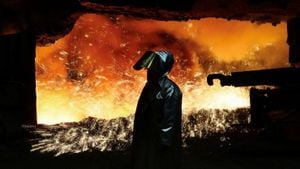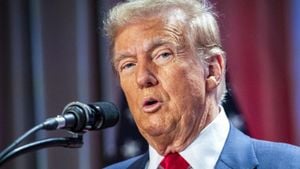A recent anti-NATO protest held in Montreal has drawn considerable attention, particularly because of the violence it incited. With images of shattered glass and damaged vehicles surfacing across media platforms, there's been heated debate over the origins and the responsibility for the fracas.
Montreal's police chief, Fady Dagher, addressed the press, clarifying once and for all what his department believed sparked the unrest. According to Dagher, the blame doesn't lie solely with the protest organizers. Instead, he indicated the violence came from individuals affiliated with what he termed as "an extreme left group". "These people have nothing to do with the pro-Palestinian cause," Dagher asserted. He acknowledged the inherent difficulty organizers face when attempting to control the actions of individuals within large, emotional gatherings. "It’s impossible for them to prevent those bent on violence from infiltrates their organized events," he added.
Quebec Premier François Legault has voiced his concerns, calling for decisive action against anyone involved. Just last week, he emphasized this urgency to Montreal Mayor Valérie Plante, stating, "There must be a very clear message sent to these thugs". He expressed his expectation for police to conduct thorough arrests, dismissing the current haul of three as grossly inadequate. "So until proven otherwise, we have confidence in the (police), but I expect there to be action in the coming days," Legault commented. This reflects rising pressure on law enforcement to respond effectively to public unrest.
Taking to social media, the so-called “Black Bloc” claimed responsibility for the vandalism as part of their anti-capitalist agenda. They issued statements asserting the necessity of their actions, stating, "Resistance is legitimate… the police can no longer have a monopoly on violence". This has led to the growing public dialogue around protest tactics and the acceptable limits of civil disobedience.
The chaotic protest took place at the convention centre hosting the NATO meeting as about 800 demonstrators gathered, organized primarily by the group Divest for Palestine and the anti-capitalist CLAC (Coalition against the capitalist system). Their protest was aimed against NATO's support for Israel amid the current geopolitical tensions stemming from the recent conflict involving Hamas and Israel.
Media reports highlighted some of the more incendiary actions, including protesters who set two cars ablaze and vandalized the convention center. Images showcased the wreckage left behind, with smashed windows framing the aftermath of the event. Protesters also utilized paint-filled fire extinguishers to obstruct the visibility of riot police, denigrated to mere collateral damage by Dagher.
Interestingly, Benoît Allard, representing Divest for Palestine, expressed his awareness of the growing anger among protestors but stopped short of lamenting the violence. Instead, he described the frustration among activists who have "been mobilizing for over a year" and highlighted the ineffectiveness of peaceful demonstrations which seem to garner little media attention. His remarks raise larger questions about the efficacy of peaceful protests versus acts of defiance.
"What do you do … when all the peaceful ways of protesting have been tested, used, and you’re not heard?" he wondered during his reflection on the event. This frustration echoes sentiments from many within the community who feel marginalized, especially as their peaceful efforts increasingly seem to go unnoticed.
Chronologically, the two protests occurred closely together; one was designated peaceful and organized to protest against weapons being sent to Israel. Allard remarked, "It was a peaceful protest. But nobody talked about it." This lack of attention seems to have stirred emotions, leading some within the group to take explosive action during the subsequent demonstration.
Quebec authorities have also faced backlash surrounding police conduct during protests, particularly related to the handling of community members deemed vulnerable. A local rabbi, Adam Scheier, reported being asked to vacate the area during yet another protest due to safety concerns expressed by officers. Scheier, donning his kippah, felt targeted amid a chaotic scene; he remarked, "The only thing I am guilty of is shopping…" Scheier's perception of unfair treatment has illuminated another layer within policing practices during high-tension situations.
Despite the orchestrated chaos surrounding these protests, Dagher reiterated, "Everybody thinks Montreal is on fire. It happened one night, one moment, at one place." He reminded the public of the city's overall safety, especially with more than 400 protests occurring peacefully since October 7, 2023, following Hamas's attack on Israel. This assertion serves to conjure images of Montreal as more than just the site of unrest but also as a community heavily engaged in public discourse.
With the dust settling from recent events, questions remain about the future of protests and their consequences. The polarizing nature of modern activism has sparked social conversations about what it means to protest effectively and the boundaries of civil unrest.
This protest and its immediate fallout has left its mark. While the conversation nears its conclusion, many are left pondering: what constitutes acceptable protest? How should communities respond when emotions run high and voices are loud? What should be the role of law enforcement? And who, if anyone, holds the ultimate key to peace amid discontent?



